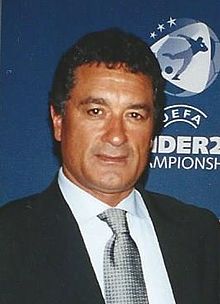Italian Libyan

Claudio Gentile, a Libya-born Italian and renowned football player.
|
|
| Total population | |
|---|---|
| 119,139 (in 1939) | |
| Regions with significant populations | |
| Tripoli, Benghazi, Khoms | |
| Languages | |
| Italian, Sicilian, other languages of Italy, Libyan Arabic | |
| Religion | |
| Christianity, mostly Roman Catholicism | |
| Related ethnic groups | |
| Italians (Italian diaspora) |
Italian settlers in Libya (Italian: Italo-libici, also called Italian Libyans) typically refers to Italians, and their descendants, who resided or were born in Italian Libya, in the colonial period preceding independent Libya.
Italian heritage in Libya can be dated back to Ancient Rome, when the Romans controlled and colonized Libya for a period of more than five centuries prior to the fall of the Roman Empire and its takeover by Arab and Turkish civilizations. But predominantly Italian heritage in Libya refers to modern-day Italians.
In 1911, the Kingdom of Italy waged war on the Ottoman Empire and captured Libya as a colony. Italian settlers were encouraged to come to Libya and did so from 1911 until the outbreak of World War II.
In less than thirty years (1911–1940), the Italians in Libya built a significant amount of public works (roads, railways, buildings, ports, etc.) and the Libyan economy flourished. They even created the Tripoli Grand Prix, an international motor racing event first held in 1925 on a racing circuit outside Tripoli (it lasted until 1940).
Italian farmers cultivated lands that had returned to native desert for many centuries, and improved Italian Libya's agriculture to international standards (even with the creation of new farm villages).
Catholicism experienced a huge growth in those years, with many new churches built for the growing Italian community: in the late 1920s the two catholic Cathedrals of Tripoli and Benghazi were built. The one in Benghazi was considered the biggest in north Africa.
The governor Italo Balbo is attributed with the creation of modern Libya in 1934, when he convinced Italian leader Benito Mussolini to unite the Italian colonies of Tripolitania, Cirenaica and the Fezzan into one single country named "Libia" in Italian.
...
Wikipedia
